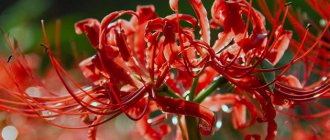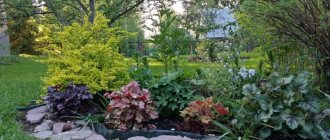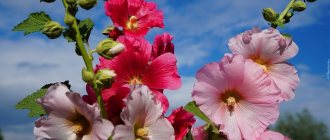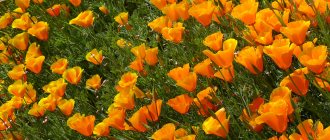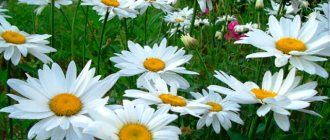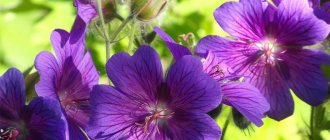The rhizomatous perennial herbaceous plant Heuchera is a member of the Saxifraga family. Today its varieties and types are highly valued in landscape design.
Photo. Heuchera in a flower bed.
Did you know that... This plant was named after the German doctor and botanist Johann Heinrich von Heicher.
The cradle of culture is the rocky regions of North America.
Heuchera bushes are compact, reach a height of about 50 centimeters, and are valued for their spectacular foliage, which attracts the eye with its sophistication.
A distinctive feature of the plant is that during one growing season its foliage can change color several times.
This crop is distinguished by an incredibly diverse color palette, as well as many options for combinations of color shades, especially for modern variegated varieties.
Brief description of the plant
- Landing. In spring, suitable months are March-April.
- Bloom . Observed in June-August.
- Lighting. Grows well in shade or in bright, but diffused light, without direct sunlight.
- The soil. Must be moisture-resistant, breathable and water-permeable with a pH of 5.0-6.0.
- Watering . Systematically water the plant when the soil dries out once every two to three days. During long periods of warm, dry weather, water the flower twice a day.
- Fertilizer . Feeding begins from the second year of growth, this is done before flowering and after flowering. To do this, use liquid complex mineral fertilizers in half the dose recommended by the manufacturer.
- Reproduction. By dividing the bush into cuttings, as well as sowing seeds.
- Insect pests. Weevils, leaf nematodes, butterfly caterpillars, snails and slugs.
- Diseases. Gray rot, stains, rust, powdery mold.
Choosing a place and soil for planting
Heuchera grows well in fertile, loose soils with neutral acidity pH 5.5–6.5. Water should not stagnate in the soil, otherwise the rhizomes will quickly begin to rot. To drain excess moisture, deep drainage is arranged in the planting areas.
Sites for heuchera are chosen so that the plants are well lit in the first half of the day. In the sun the leaves become brighter. Some varieties prefer partial shade or shaded areas. Heuchera is often planted in the garden in the trunks of fruit trees and shrubs.
Appearance
Heuchera is a compact and dense bush, which consists of blades of long-leaved, leathery leaves with a jagged edge.
Photo. Heuchera leaves.
The color and shape of the leaves are very diverse. They can be almost black, brown, pink, yellow, deep red, amber, purple, green and even silver, and have various veins, patterns and spots on their surface. The texture of the leaf plates is corrugated, smooth and curly. The bushes are decorated with flowers throughout the summer, and in some cases even until the first frost.
Photo. Heuchera flowering.
Paniculate inflorescences consist of small bells of white, red, pink or cream color. The fruit is a capsule containing many seeds the size of a poppy seed (1 g contains about 20,000 seeds).
3.Varieties:
3.1. Heuchera marmalade
Decorative foliage plant with a height of 25 to 45 cm. The leaf blades are distinguished by elegant corrugated edges. Leaf shades include light green, orange, coral, and pink. During the summer months, the plant produces thin, erect flower stalks with small burgundy flowers. Young shoots of plants have delicate pubescence.
↑ Up,
3.2. Heuchera bloody red - Heuchera sanguinea
The plant can be safely classified as both flowering and decorative foliage. The relatively tall bushes reach a height of 30 - 45 cm. The leaves are light green, on long, thin basal petioles. The leaf petioles and peduncles are covered with attractive pubescence. Each plant can throw out up to several dozen erect, thin peduncles bearing bright burgundy, red, and crimson flowers at the tops. The flowering period begins in May and lasts until July. The flowers have a pleasant sweetish aroma.
↑ Up,
3.3.Heuchera Caramel
A compact, perennial, decorative foliage plant with a height of 20 to 45 cm. In warm climates, the plants remain evergreen, but with the onset of frost, the above-ground part may die off. The leaves are rounded, on high basal petioles. An interesting feature of the variety is that in spring the young leaves are colored reddish, and in the summer months the leaf blades acquire a golden-yellow color.
↑ Up,
3.4. Heuchera Peach Flambe
Plants of this variety have a very bright, attractive appearance. The height of the bushes is 30 - 40 cm. The leaves are rounded, palmately cut, on high, thin petioles. The leaf blades are colored in a catchy coral, red, burgundy shade. The peduncles are numerous, erect, bearing very small, delicate, white or pink flowers at the tops.
↑ Up,
3.5. Small-flowered heuchera - Heuchera micrantha
Small-flowered heuchera is a tall herbaceous perennial plant with glossy, basal leaves on very long petioles. Thin, vertical flower stalks can reach 1 meter in height. The leaf blades are green, purple or reddish in color. The flowers are very small, pink or white.
↑ Up,
3.6.Heuchera micrantha Palace Purple
Attractive herbaceous perennials that form large, rounded bushes. The height of the plant reaches 30 - 60 cm. The leaves are rounded, on long, thin, basal petioles. The leaf blades are glossy, dark violet or purple. The peduncles are thin, numerous, erect, bearing inflorescences at the tops - loose panicles with very small pink or white flowers. An interesting feature of the variety is that with the onset of hot summer weather, the color of the leaves may change to green.
↑ Up,
3.7.Heuchera Midnight Rose Select
Valuable decorative foliage plants with a very impressive appearance and compact dimensions. Even adult plants reach a height of only 20 - 30 cm. The rounded, palmately cut leaf blades of this plant are painted in a dark purple or burgundy shade with small pink specks on the surface.
↑ Up,
3.8. Heuchera Lime Rickey
Decorative leafy perennials with a very delicate appearance. The rounded, corrugated leaves, as well as the leaf petioles and peduncles, are painted in a delicate light green shade. During the flowering period, each bush throws out vertical, thin, pubescent peduncles, reaching 25 - 45 cm in height. The flowers are small, white, and have a pleasant aroma.
↑ Up,
3.9. Heuchera hybrid Obsidian - Heuchera hibrida Obsidian
Compact ground cover plants up to 25 cm high. This species is considered the darkest variety of heuchera. The leaves are round, with large teeth along the edges, on long basal petioles. The leaf blades are glossy, almost black, painted in a dark burgundy or dark purple hue. Tall erect peduncles bear small white or cream flowers at the tops, collected in loose panicles.
↑ Up,
3.10.Heuchera brizoides
A perennial plant from 30 to 60 cm in height with attractive leaves and colorful flowers. The leaf blades are glossy, painted bright green, have a rounded shape and large teeth along the edges. The peduncles are tall, erect, covered with attractive pubescence, bearing small pink or coral, bell-shaped flowers at the tops.
↑ Up,
Characteristic
If you do not plan to collect seeds, you can cut the flowers.
It is not difficult to grow heuchera on your own plot, but it has several features that a gardener who decides to grow this perennial species should know:
— If you grow decorative and deciduous varieties of heuchera, then you need to cut off the flower stalks that appear in the bushes; they tower above the plants and look extremely disorderly. Peduncles are left only if the seeds are going to be collected in the fall.
— In decorative flowering varieties, the flower stems are cut off immediately after flowering. The lower foliage flies off over time, which negatively affects the decoration of the plant.
And a note! Before the bush begins to bloom, it is taken out of the ground and planted in a new, deeper hole with clods of earth, thanks to this it will be possible to hide the bald trunk.
- Young foliage begins to grow in rich, translucent colors (similar to flower petals), but becomes darker and denser over time.
— Heuchera bushes go well with daylilies, primroses, astilbe and ornamental grasses.
Flowering time
The culture throws out its first flower stalks in early June, the last at the end of August or early September. In fact, throughout the summer months, your site will be decorated with picturesque flowering bushes. Although climatic conditions, characteristics of the variety and content are varying factors in the duration of the stage.
In some varieties, panicles even with small bells look original.
In others, the flowering is rather inconspicuous
Still others have peduncles with lush panicles that can compete in attractiveness with other garden flowers. This completely depends on the varietal of the plant.
But in a bouquet, even the most inexpressive heuchera inflorescences successfully complement lilies and roses, and in the area they advantageously set off other neighbors in the flowerbed. Instances with bright colors become an equal element in a mixborder and any other composition.
Planting heuchera in open ground
We plant heuchera.
Illustration taken from open sources. What time to plant?
Plants are planted in open ground in March-April. This plant loves shade and partial shade, so we recommend choosing an area that will be shaded by other crops. The diffused sun should fall on the flower.
On a note! Choose a place located in the western or eastern part of the garden; direct sunlight should fall on it only in the morning or evening.
If a sunny zone was chosen for the heuchera, the plant will need to be watered systematically and very abundantly. It was noted that if varieties with bright foliage are grown in well-lit open areas, then their color becomes more saturated and spectacular. It should be noted that varieties with red foliage are recommended to be grown only in sunny areas, otherwise their color will be green after shading.
Growing heuchera from seeds
Sowing heuchera for seedlings
Heuchera reproduces well by seed, but its seed remains viable for no more than six months, so when purchasing, check the packaging date. Seeds are stored in foil bags longer - up to one and a half years. It is not necessary to stratify seeds before sowing.
Sow heuchera seeds in a wide box or container at least 5 cm high with drainage holes so that excess water flows freely into the pan without stagnating in the roots of the seedlings. The soil for heuchera should be loose, moisture- and breathable. You can purchase a substrate for seedlings at a garden pavilion, dilute it by a third with perlite or sand, mix thoroughly, and then heat it in the microwave for 5-7 minutes to disinfect. You can also sterilize the substrate by spilling it with boiling water or a solution of potassium permanganate. Prepare the soil two weeks before sowing, so that during this time the beneficial microflora can be restored.
Sowing is carried out in March or April, having previously mixed very small heuchera seeds with sand to make it easier to evenly distribute them over the surface of a moist, loosened and leveled substrate. The seeds are not buried, but simply pressed lightly to the ground, after which the crops are covered with film or glass and placed in the brightest place in the apartment, protecting them from direct sunlight and drafts. Contain crops at a temperature of 20-22 ºC. In such conditions, seedlings may appear in 2-4 weeks, although sometimes more time may pass: heuchera from seeds germinates and develops slowly, but there is no need to worry about this.
Caring for heuchera seedlings
Crops need to be ventilated daily, leaving them uncovered for half an hour. As soon as the first shoots begin to appear, make holes in the film for air access, but do not remove it. If you covered your crops with glass, move it slightly so that the seedlings can breathe through the gap. The coating can be removed when massive seed germination begins.
At the stage of development of three true leaves, heuchera seedlings are planted in separate cups or in a common container, but maintaining a step of 4-6 cm between them. Keep the substrate slightly moist, but do not allow it to become waterlogged. After watering, carefully loosen the substrate around the seedlings.
The soil
The culture is not particularly demanding on the soil and can grow on any soil except acidic soil; it is better if the pH is 5-6. It can grow on rocky soil, as the plant is naturally found on the rocky shores of the Great Lakes of North America.
On a note! Remember that the looser and more nutritious the soil, the more spectacular and dense the bush will be.
Particular attention should be paid to the moisture capacity of the soil, and it must allow water and air to pass through well. The plant reacts negatively to stagnant fluids in the root system.
Heuchera transplant
Experts do not recommend replanting young bushes. Only strong, mature plants can be replanted. If you transplant a young heuchera, it may die.
When digging, be careful not to damage the fragile root system. Ash should be poured into the prepared planting hole.
Healthy and mature plants tolerate replanting well and easily take root in almost any part of the garden.
Landing rules
Heuchera seeds ripen after flowering.
Heuchera can be grown from seeds, or you can buy ready-made seedlings. Sowing is done in prepared loose soil and covered.
On a note! If you want to grow a crop from seeds, keep in mind that the seedlings cannot retain the varietal characteristics of the mother plant, and all you can grow is a simple bush with green foliage.
If you decide to grow a flower from seeds, we recommend doing it through seedlings. The seedlings are grown in a greenhouse, after which they are planted in open ground, maintaining a distance between bushes of at least 20 centimeters, and they are buried in the soil only 3-4 cm.
Heuchera care video
Today, heucheras are considered the most attractive and popular decorative foliage plants, which are gladly used by gardeners for landscaping the garden.
The flower is distinguished by a wide variety of shades and shapes of leaves, as well as a completely unpretentious character, resistance to diseases and pests. In addition, heuchera is frost-resistant and easily overwinters in the garden. It is often planted in flower beds, rockeries, rock gardens and on central paths. You can also share your secrets for caring for heuchera. If you have questions, ask them in the comments below, we will be happy to answer them.
Top dressing
Don't forget to feed the plant.
After planting in the first year of growth, the bush does not need feeding. Then annually during the growing season. If you grow ornamental and deciduous varieties, then complex mineral fertilizers for deciduous plants are used for fertilizing, and when growing ornamental and flowering varieties, use universal fertilizers for flowering plants. Fertilizers are applied to the soil twice a season, namely before and after flowering, using half the dose recommended by the manufacturer .
Watering
Flowers should be watered regularly once every two days immediately after the topsoil has dried. Heuchera is one of the plants that tolerate drought much better than stagnation of liquids in the root system. But during long warm and dry periods, watering is carried out twice a day (early morning and late evening). Water the bushes very carefully, pouring water under the root and not allowing drops to fall on the surface of the foliage, as this can cause burns.
To avoid frequent weeding and regular loosening, in the spring after watering, the soil surface is covered with a layer of mulch (peat).
Care
Watering
Both waterlogging and overdrying of the soil are harmful to heuchera. In hot weather, the bushes are watered abundantly 2-3 times a week. After watering, the plants are loosened superficially so as not to damage the small roots. Mulching with plant residues and peat retains moisture well.
Feeding
Under natural conditions, heuchera can grow in poor soils. But in cultivation, in order for plants to show their decorative properties, they need additional nutrition.
Fertilizing should be moderate; excessive use of fertilizers leads to the occurrence of diseases.
On soils rich in organic matter, the first year of heuchera can do without fertilizing. Subsequently, the plants are fed with mineral complexes. The concentration of nutrients should be 2 times less than recommended in the instructions. During the summer, it is useful to dust young bushes with ash several times.
Transfer
Heuchera needs to be rejuvenated every 3-4 years. With a longer period of cultivation, the plant looks less decorative, becomes smaller, overwinters worse and may die.
In spring, heuchera roots and young rosettes often protrude to the soil surface and become bare. Therefore, every year the bushes are hilled up or an additional layer of earth is added around them.
Trimming
In young and immature plants, as well as in varieties valued for the beauty of their foliage, emerging flower stalks are cut off. This will save energy for the heucheras. They will direct them not to flowering and ripening seeds, but to increasing leaf mass. In varieties with beautiful flowers, pruning faded flower stalks stimulates the appearance of new ones.
During the summer, as young leaves grow, old foliage is gradually cut off. For winter, shoots and leaves of heuchera are not cut off.
Shelter for the winter
Some varieties, especially those with light leaves, and young heucheras need winter shelter. It will protect the bushes not only from frost, but also from spring burns. In the fall, the soil around the plant is covered with a layer of moss or mulch, and on top with spruce branches or lutrasil. The shelter should not be dense, otherwise the heucheras may dry out.
Plants that were planted in containers are brought indoors for the winter. A basement or a glazed and insulated terrace is suitable for this.
Reproduction
Photo.
Perennial heuchera. Once the bush reaches three to four years of age, a bare middle may appear as the bush's output in most cases disintegrates. If this happens, then the flower should be rejuvenated.
To do this, they dig it up, divide it into several parts, and each piece is planted in a new place.
The division of the bush is carried out in May or in the first weeks of autumn. It should be borne in mind that each division should have two or three processes. If the roots of the division are excessively long, they are shortened and if there is rot on them, then all affected parts are cut off, and the cut areas are sprinkled with crushed charcoal.
Pests and diseases
The culture is very resistant to insect pests and various diseases. However, it can rarely be affected by rust, stains, powdery mildew or gray mold. As a rule, this is due to the fact that the liquid regularly stagnates in the root system or an excessive amount of fertilizer in the soil.
If a whitish coating appears on the foliage, then the plant is affected by powdery mildew. To cure it, treatment with fungicidal drugs is necessary. If the flower is sick with rust or spots, it needs to be sprayed every two weeks with a solution of Bordeaux mixture.
Insect pests that can harm the plant include slugs, caterpillars, snails, weevils or leaf nematodes. To destroy them, the bush is treated with special insecticidal preparations.
Wintering
Autumn has arrived, which means we need to take care of the wintering of Heuchera.
The crop is quite frost-resistant in open fields. In autumn, yellowed and dried leaf blades cannot be cut from the bush, since in winter they protect the root system from frost. The plant should be covered for the winter, while it is recommended to use covered oak leaves as cover. With the arrival of spring, the cover is removed, and the old foliage from the bush is carefully trimmed with pruning shears as close to the surface of the area as possible.
